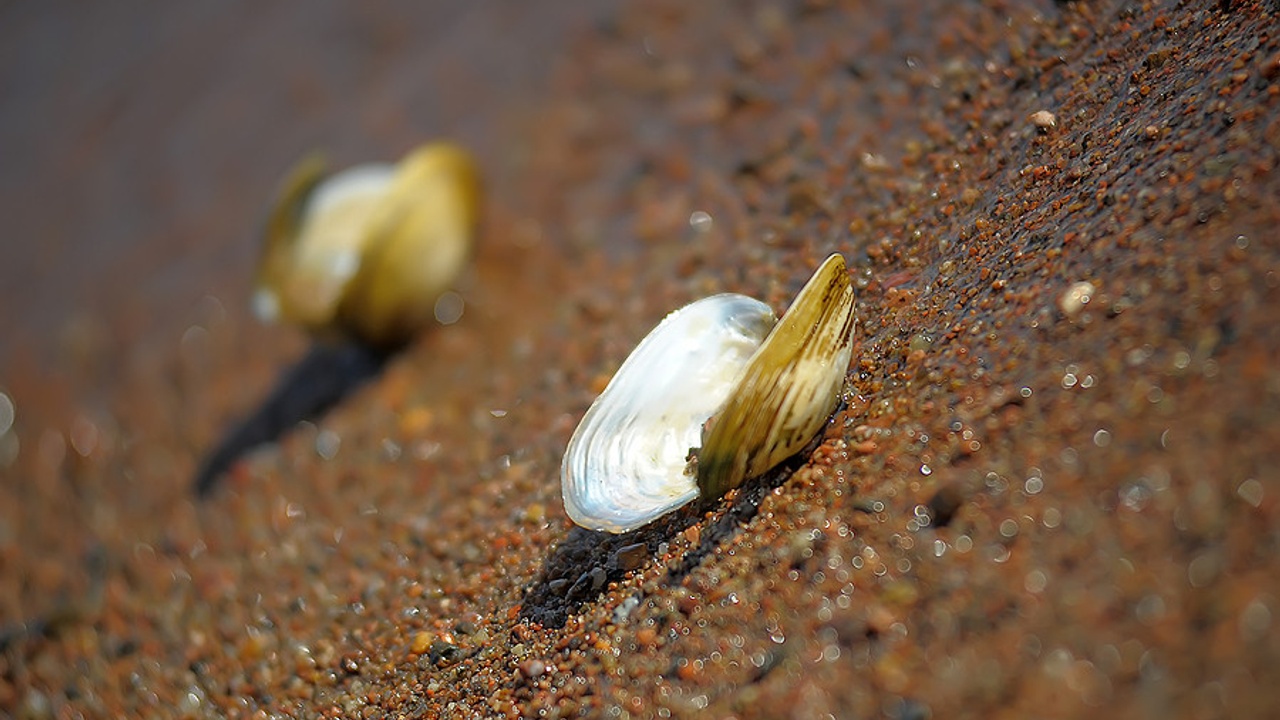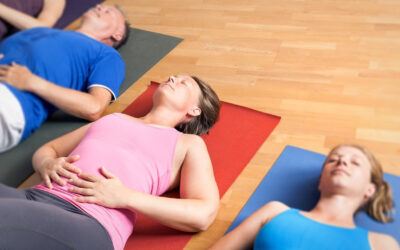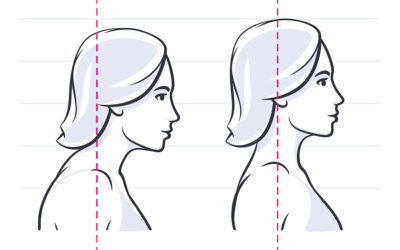The clamshell is a classic exercise that’s typically given to strengthen the gluteus medius through external hip rotation. Unfortunately, many people often perform the exercise without proper positioning, muscle integration, and breathing. Something I often tell my clients is, We don’t want to strengthen a crooked body or bad movement mechanics. Doing so only perpetuates compensations and pain.
Proper Clamshell Set-up
 The first thing we need to consider in preparing for this exercise is the position of the gluteus medius. As you can see in the image to the right, the top of the glute med attaches to a part of the pelvis called the ilium bone. The glute med attaches itself to this bone at the top in an open fan shape. The muscle then narrows down to connect to the leg bone (femur). Recall that the top of the femur is referred to as the hip, which is in the shape of a ball. This “ball” on the top of the femur integrates with the acetabulum (depression) of the pelvis, forming the hip joint. Consequently, the orientation of these bones impacts both the length and tension of the gluteus medius as well as its ability to contract during the clamshell exercise.
The first thing we need to consider in preparing for this exercise is the position of the gluteus medius. As you can see in the image to the right, the top of the glute med attaches to a part of the pelvis called the ilium bone. The glute med attaches itself to this bone at the top in an open fan shape. The muscle then narrows down to connect to the leg bone (femur). Recall that the top of the femur is referred to as the hip, which is in the shape of a ball. This “ball” on the top of the femur integrates with the acetabulum (depression) of the pelvis, forming the hip joint. Consequently, the orientation of these bones impacts both the length and tension of the gluteus medius as well as its ability to contract during the clamshell exercise.
The second and related thing we need to consider in our set-up is coordination of the surrounding muscles, many of which assist in maintaining the position of the pelvis, hip, and femur. These muscles include the abdominals, adductors (inner thigh), and hamstrings. Nothing in the body works in isolation! Additionally, efficient movement requires activation of several muscles in correct, sequenced patterns.
Okay, now that you’ve heard my spiel, let’s get to the exercise.
Exercise Technique
 First, lie down on your side with your legs at a 90-degree angle with your feet flexed.
First, lie down on your side with your legs at a 90-degree angle with your feet flexed.- Second, prop yourself up on your elbow. Make sure that your elbow is directly under your shoulder.
- Third, exhale out your mouth and tuck your pelvis under (posterior tilt) to lengthen your back. You should feel your abdominals engage as you do this. Think of this like a crunch on the floor where you are lying on your back, except that you are in a sidelying position.
- Fourth, press the hip that is on the floor down into the ground to help stabilize the pelvis. Simultaneously, tilt your top hip towards your feet to lengthen your lower back and side. It is unfortunately common to compensate with your back and/or oblique abdominals during this exercise. However, the movement needs to come from the hip.
 Fifth, inhale through your nose and slide your top knee forward. This will rotate your pelvis toward the hip on the floor. This helps to position your femur (hip) correctly in your pelvis. Doing this will also lengthen the gluteus medius muscle you will be lifting. You could also think of this in the reverse–sliding your lower hip back. You may feel the hamstrings engage in your lower leg.
Fifth, inhale through your nose and slide your top knee forward. This will rotate your pelvis toward the hip on the floor. This helps to position your femur (hip) correctly in your pelvis. Doing this will also lengthen the gluteus medius muscle you will be lifting. You could also think of this in the reverse–sliding your lower hip back. You may feel the hamstrings engage in your lower leg.
NOTE: The cool thing about doing the clamshell exercise in this position is that you are working both sides of your pelvis together. Don’t be surprised if your stationary glute med, the one on the floor, fatigues quicker than the muscle doing the lifting. This happens because the stationary muscle is working hard to stabilize your posture.- Sixth, press down into your elbow on the floor to engage your side abdominals.
 Seventh, exhale out your mouth as you lift your top knee. Then, inhale through your nose as you lower your knee. Maintain your position–including abdominal engagement and a lengthened lower back–throughout the movement. Your knee may not lift very high, which is fine. However, you should feel it in your glute med.
Seventh, exhale out your mouth as you lift your top knee. Then, inhale through your nose as you lower your knee. Maintain your position–including abdominal engagement and a lengthened lower back–throughout the movement. Your knee may not lift very high, which is fine. However, you should feel it in your glute med.
NOTE: If you feel a tightening behind the pocket of your pants or shorts, you are doing it right. However, if the tension is at your pocket (directly on the side of your hip) or in front of your pocket, you are using accessory muscles (think TFL). In that case, you want to come out of the position and re-set.- Eighth, perform only as many repetitions as you can with good form. Then switch sides. When you can do two sets of 15 repetitions, increase the demand of the exercise.
Clamshell Progressions
Bodyweight
I always start my clients using only the weight of their body. Technique can decline when resistance is added, and as you’ve surely noticed, there are a lot of steps to combine before adding an additional challenge. By the way, this may seem more taxing for your brain than your body at first.
Add Resistance
Here are three options to add resistance:
- Hand Pressure – Place your hand on the side of your thigh. The closer your hand is to your hip, the easier the lift will be. Inversely, the closer your hand is to your knee, the harder the lift will be. You are in control of how much pressure you use. Start easy and build up.
 Dumbbell – This is the same technique as with your hand, but instead, use a dumbbell. Increase weight as you get stronger.
Dumbbell – This is the same technique as with your hand, but instead, use a dumbbell. Increase weight as you get stronger.- Band – Place the band around both legs and bring it up just above your knees. The band should be loose to start and tighten enough so that you feel resistance as you move your leg up, but not so tight and heavy that you can barely lift your leg. Bands come in several strengths, so again, you should start easy and build up.
The Gluteus Medius is Also an Internal Hip Rotator!
Although the glute med is generally thought of as only performing external hip rotation and is strengthened accordingly, like with the clamshell exercise, it also acts in the opposite direction. The gluteus medius is a dual-purpose muscle! The front of the muscle does one action, and the back does the other. The posterior (back) fibers externally rotate the hip while the anterior (front) fibers internally rotate the hip.
And, to further complicate the role of the gluteus medius in the body . . . rotation is only the transverse plane (around the body) function of the muscle. It also acts in the sagittal (front to back) and frontal (side to side) planes! But don’t worry. I won’t add in that complexity right now since rotation is its most crucial job. According to the Postural Restoration Institute©, hip internal rotation is more important than external rotation for function.
The Reverse Clamshell Exercise for the Gluteus Medius
A balanced muscle is a strong muscle. If you strengthen the glute med in external rotation, you also need to strengthen it in internal rotation. Just like with the clamshell exercise, you need to think about proper positioning, muscle coordination, and breathing in this exercise.
 First, lie on your side at a 90-degree angle.
First, lie on your side at a 90-degree angle.- Second, place your hand under your head or use a small pillow for support.
- Third, place a 4” block, ball, pillow, or towel between your knees.
- Fourth, exhale out your mouth and tuck your pelvis under (posterior tilt) to lengthen your back. You should feel your abdominals engage as you do this. Think of this like a crunch on the floor where you are lying on your back, except that you are in a sidelying position.
 Fifth, press the hip that is on the floor down into the ground to help stabilize the pelvis.
Fifth, press the hip that is on the floor down into the ground to help stabilize the pelvis.- Sixth, inhale through your nose as you slide your upper hip back so that your top knee is behind your bottom knee. Your pelvis will rotate toward the top leg. You could also think of this in the reverse–sliding your lower hip forward. You may feel the hamstrings engage in your upper leg. Don’t arch your back!
- Seventh, exhale out your mouth as you press your top knee straight down into the block to engage the inner thigh.
 Eighth, keep pressing into the block with your knee while you rotate your hip inward. Your top foot will come off the wall and rotate up. You should now feel your glute med working along with your inner thigh and abdominals.
Eighth, keep pressing into the block with your knee while you rotate your hip inward. Your top foot will come off the wall and rotate up. You should now feel your glute med working along with your inner thigh and abdominals.- Ninth, hold the hip shifted back position and perform several repetitions of lifting and lowering the leg. Switch sides when fatigued.
Summary
Keeping your gluteus medius balanced and fit is important for your posture and performance. The clamshell exercise is a good way to build strength in external rotation. However, of possible even greater significance is strengthening the gluteus medius in internal rotation with the reverse clamshell exercise. When retraining muscle mechanics and creating new movement patterns, you want to start with isolated exercises on the ground. This controlled environment helps prevent compensation and reduces distractions. Once you feel proficient in these exercises, it is time to move on to more complex multi-joint movements in gravity that use the gluteus medius, such as the band walk.



